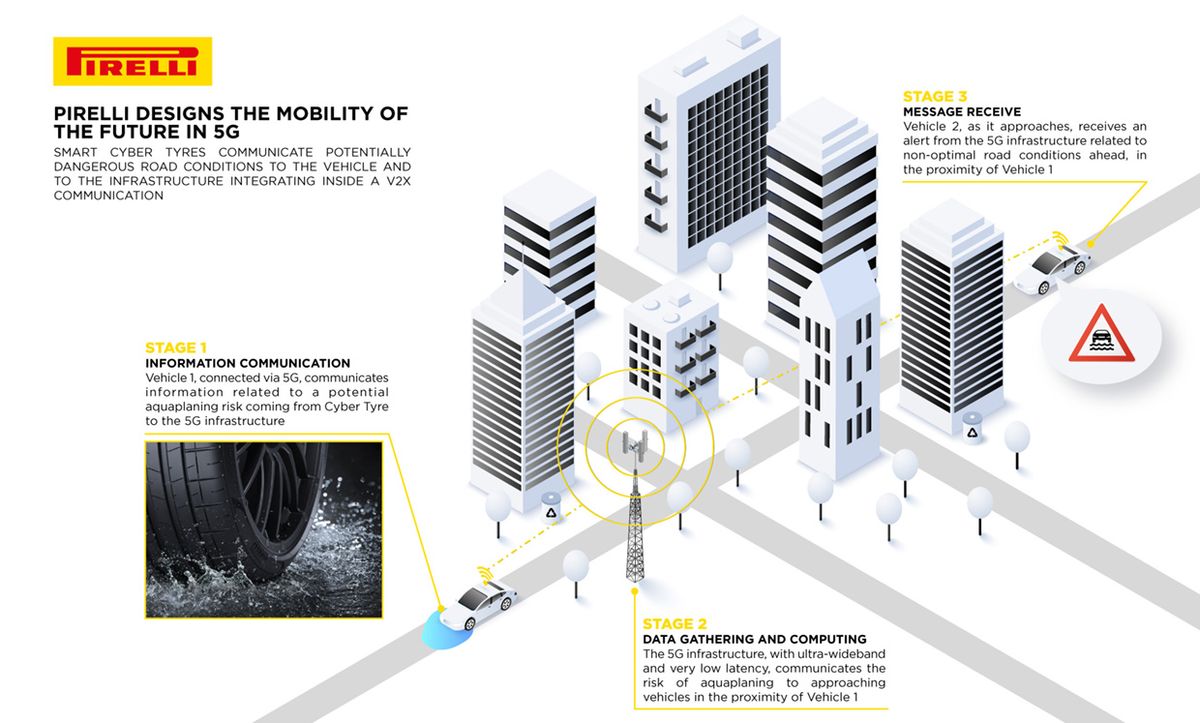The term “5G” typically makes people think of the smartphone in their hand, not the tires on their car. But Pirelli has developed the Cyber Tire, a smart tire that reads the road surface and transmits key data — including the potential risk of hydroplaning — along a 5G communications network.
Pirelli demonstrated its Cyber Tire (also known as the Cyber Tyre) at a conference hosted by the 5G Automotive Association, atop the architect Renzo Piano’s reworking of the landmark Lingotto Building in Turin, Italy. That’s the former Fiat factory where classic models such as the Torpedo and 500 (the latter known as Topolino, or “Little Mouse”) barrelled around its banked, three-quarter-mile rooftop test track beginning in the 1920’s. Engineers of that era, of course, couldn’t begin to fathom how digital technology would transform automobiles, let alone the revolution in tires that has dramatically boosted their performance, durability and safety.
Using an Audi A8 as its test car, Pirelli’s network-enabled tires sent real-time warnings of slippery conditions to a following Audi Q8, taking advantage of the ultra-high bandwidth and low latency of 5G. Corrado Rocca, head of Cyber R&D for Pirelli, said that an accelerometer mounted within the tire itself—rather than the wheel rims that send familiar tire-pressure readouts in many modern cars—precisely measures handling forces along three axes. That includes the ability to sense water, ice or other low-coefficient of friction roadway conditions.
The sensor data can be used to the immediate benefit of safety and autonomous systems onboard a car. It can also be used in the growing realm of vehicle-to-vehicle (V2V) or vehicle-to-x communications (V2X), which means the once-humble tire could become a critical player in a wider ecosystem of networked safety and traffic management. Obvious scenarios include a car on the freeway that suddenly encounters ice, with tires that instantly send visual or audio hazard warnings not only to that car but also to nearby vehicle and pedestrians, as well as to networked roadway signs that announce the potential danger, or adjust prevailing speed limits accordingly.
“No other element of a car is as connected to the road as the tire,” Rocca reminds us. “There are many modern sensors; lidar, sonar, cameras, but nothing on the ‘touching’ side of the car.’”
Virtually every new car is equipped with anti-lock brakes (ABS) and electronic stability control (ESC) systems, which also spring into action when a car’s wheels begin to slip, or when a car begins to slide off the driver’s intended course. But the Cyber Tire could further improve those systems, Rocca said, allowing a car to proactively adjust those safety systems, or automatically slow itself down in response to changing roadway conditions.
“Because we’re sensing the ground constantly, we can warn of the risk of hydroplaning well before you lose control,” Rocca says. “The warning could appear on a screen, or the car could automatically decide to correct it with ABS or ESC.”
Aside from data on dynamic loads, the Cyber Tire’s internal sensor might also communicate in-car information specific to that tire model, or the kilometers of travel it has absorbed.
Pirelli is also developing the technology for race circuits and driving enthusiasts, with its Italia Track Adrenaline tire. With tire temperatures dramatically affecting traction, wear and safety, this version monitors temperatures, pressure and handling forces in real time. That combines with onboard GPS and telemetry data to help drivers improve their on-track skills. The system could deliver simple real-time instructions — such as color-coded screen readouts as a tire rises to or beyond optimal operating temperature—or using popular telemetry tools, a granular analysis of the tire’s performance after a lapping session. (At the highest levels of Formula One racing, cars are equipped with roughly 140 sensors, which collect 20 to 30 megabytes of telemetry data every lap).
With 5G, V2V and V2X systems still in the development phase, Pirelli can’t say when it sensor-enabled hunks of rubber will reach the market. Automakers ultimately lead the adoption of new tire technology, and many are leery of new tech until they’re sure consumers will pay for it. Car companies are also cautious about ceding the networked space in their cars to outside suppliers—witness their glacial, grudging adoption of Apple CarPlay and Android Auto. But Pirelli says it’s working with major automakers on integrating the technology. And Rocca says that, like ABS in its nascent stages, smart tires could become common on vehicles within a decade. It’s almost enough to get us wishing for a winter storm to try them out.
Lawrence Ulrich is an award-winning auto writer and former chief auto critic at The New York Times and The Detroit Free Press.



